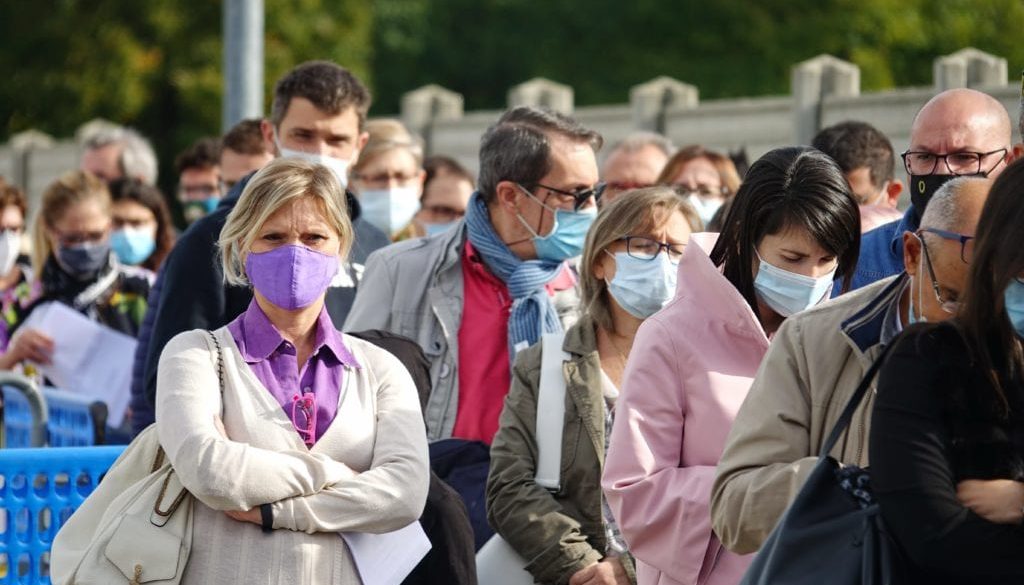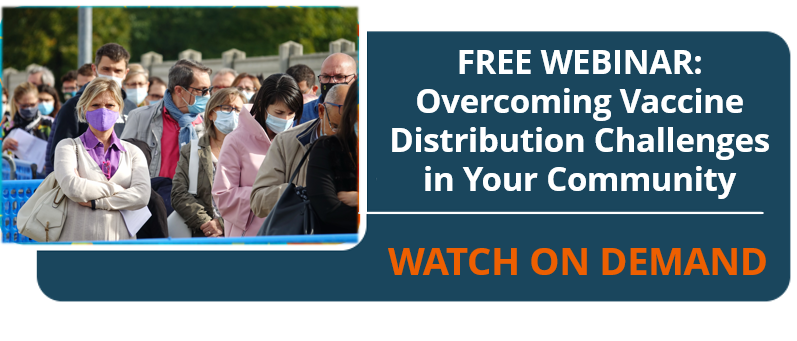Relever les défis de la distribution des vaccins dans votre communauté – Récapitulatif du webinaire
Vaccine distribution in the United States has had its challenges. While many areas of the country have been very successful in their vaccine rollout, other states have struggled with varying circumstances that have slowed access and distribution.
Todd Miller, Rave’s senior vice president of strategic programs, presented on general vaccine updates, expanded FEMA funding, as well as best practices and use cases from state and local agencies.
General Vaccine Updates
The Centers for Disease Control and Prevention are currently reporting that there are approximately 31 million people who have received two doses and 59 million who have received one dose. As vaccines continue to be administered, there are still concerns that people are getting their doses in a timely manner.
States, counties, and local governments continue to combat a variety of challenges that impact distribution, including winter weather, community engagement, vaccine hesitancy and allocation, as well as logistical hurdles.
Expanded FEMA Funding
The Federal Emergency Management Agency (FEMA) is set to retroactively reimburse states for 100% of their eligible COVID-19 costs dating back to January 2020. Originally, states were required to pay a 25% cost-share for FEMA eligible expenses under the COVID-19 federal disaster declaration. This reimbursement is estimated to save states between $3 billion to $5 billion in emergency aid.
The turnaround of funding allows for state and local agencies to be investing fully in their community’s safety and have more available resources for vaccine distribution and administration.
Miller shares, “After a request is submitted, reviewed and validated, FEMA now has the ability to expedite that reimbursement for eligible emergency use to ensure resources are available to support vaccine distribution and administration.”
Additionally, FEMA has published a Community Vaccine Centers Playbook that establishes guidance for providing federal support to state, tribal, and territory vaccination centers. The playbook information includes interagency coordination, resource support, facility set up and other requirements that are important to consider when setting up a vaccination program.
2021 Survey Results: Evidence of Confusion and Uncertainty Throughout Communities
Rave recently commissioned a national emergency communication and public safety survey conducted by ResearchScape that asked a number of questions about how members of the community engaged with public safety, public health and other government officials.
“What stood out was that, unfortunately, only about 13% of respondents felt completely confident in their state’s ability to successfully distribute the vaccine,” Miller said. There is a clear lack of trust among residents regarding their state’s ability to effectively communicate and successfully distribute the vaccine. There was a near-even split between those who have heard about vaccine rollout in their state (53%) and those who have not (47%). Miller said, “We need to think more about how we are communicating to the public and how they like to receive messages from officials.”
Use Cases from State & Local Agencies
Communities that are partnering with Rave at the state and local level are working to identify different populations and how they align with the various phases of the rollout. They’re especially focused on identifying vulnerable populations, including individuals 65+ and those with comorbidities. However, preferred communication methods differ for every population.
“We had one customer recently tell us they had a lot of success using text messaging for younger populations and voice alerting, so calling mobile numbers or landlines, for older community members,” Miller said. “Email is all-encompassing but we also recognize how overused emails are in the pandemic.”
Others have used the Rave platform for proactive voice calls to residents informing them of upcoming vaccine availability and how to make an appointment.
Health systems and hospitals are using Rave and focusing on those first responder communities to make sure they are getting their second doses. State and local officials are putting a real effort into making sure every dose is taken and doesn’t go to waste.
“Some Rave customers are using our system for vaccine pre-registration. Making sure that they are queuing up a line of citizens that are eligible in the area,” Miller said. “In some communities, we have situations where vaccines are going unused because they are not able to get them into the arms of individuals fast enough. They are using Rave’s polling feature to reach out to the community and letting them know where to go for a vaccine.”
No matter the method of communication, it is critical to have a multimodal communication approach. Being able to distribute messages in Spanish, for example, help to ensure that there is effective communication with the entire community.
“No one single mode of communication is going to reach all of your users all the time,” Miller said.
Best Practices
Some key best practices for Effective distribution/community engagement Todd Miller presented include:
- Communicate from trusted sources
- Allow residents to choose their trusted mode of communication
- Leverage crowd-sourced data to identify priority candidates
From the survey results, most residents said hearing from public safety and public health officials are viewed more favorably than elected officials. Communicating from trusted sources to an individual’s preferred mode of communication means they are most likely to receive the message.
Question & Answers
Q: Are mass notification solutions eligible for expenses for FEMA?
A: Yes! The administration and FEMA and Health and Human Services have clearly outlined that communication capabilities with the public are an allowable and covered expense.
Hear the rest of the Q&A in the webinar.





